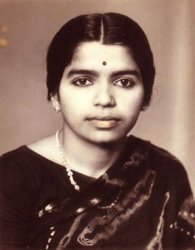
 The
world of T K Padmini The
world of T K Padmini
- Padma Jayaraj,
Thrissur
e-mail: padmajayaraj@gmail.com
October 10,
2008
An exhibition
of paintings and drawings of T K Padmini by Kerala Lalita Kala Academy
was inaugurated by its deputy chair person, Savithri Rajeevan at Durbar
Hall Art Centre, Ernakulam. The just concluded exhibition showcased
the world of late T K Padmini, a talented artist whose life was nipped
in the bud (1940-69).
Here is a
world inhabited by rural folk that tell of human tales rooted in their
innocent yet complex nature. Drawn in dark hues, they enliven the rural
stretch of Kerala of the mid 20th century. Men and women are seen against
familiar landmarks of a village: its foliage, hills and valleys, fields
and ponds, shrines and temples. Labourers are at work or they relax under
shady trees. Hindus and Muslims of her village live here evoking nostalgia
for a lost ethos. They are the sketches of an artist who loved them.
Primarily,
it is a kaleidoscope of the feminine in rural Kerala, perceived by a woman
artist. Padmini explores a woman's sensibilities. Women live here in harmony
with nature. They are part of a planet where trees, birds, and animals
cohabit. They work, relax, and dream. There is a celebration of the female
body in different postures with a marked intensity of expression. With
minimalism, the women in their postures suggest a strong desire for freedom,
even sexual freedom. Theirs are the stories of relationships as well. Innocent
girl and boy go to school together; girl children enjoy games; maidens
dream of love and sex. Bonding runs as an underlying theme in the innumerable
sketches of women.
Padmini's pictorial
art uncovers a sombre world drawn in brooding hues. The artist takes us
to the darker side. Love and relationships are cast in an aura of mystery.
Sexuality, loneliness, and protest light up her figures. Sexual joys enrapture
both the male and the female, a feature of typical Indian aesthetics rooted
in our traditional art. Does friendship between women connote a physical
attraction? A couple stand under the Tree of Life. And here is a
family where the woman is half-hidden behind her man who carries her child.
Yet another picture shows a woman watching her man carrying her child on
his shoulders with glee as she stands carefree. Is it a protest against
the social order that makes a woman a beast of burden within domestic walls?
Women proud of motherhood and untroubled girl children take over Padmini's
art world. Here, under a tree sit a couple, their ways parting in opposite
directions. The theme of separation is as old as human love and life. In
contrast, an old woman keeps vigil over her dying companion. Death and
loneliness too is part of life. Melancholy overlaps her works. The artist
unfolds the other dimension of her perceived object. There is a marked
shift from sense experiences to unifying ideas, from the mutable aspect
to an ever-present situation.
The backdrop
of her paintings and sketches are unique. Night is a persistent setting
to her cast, which lends depth, poetry, and secrecy. The back ground in
dark hues is so over powering that they intrude into the foreground, suggesting
inscrutability as a phenomenon of life. Time zone does not exist here.
Death makes his presence felt. One question that lingers in our mind is
why these shades of black and grey? Is it the influence of kalamezhuthu,
ritualistic designs associated with the worship of snakes and Mother Goddess
in Kerala?
Expressionism
gives touches to her artscape. More than form, the intensity of expressions
radiate from curves and lines, which are tell-tale marks. Subtle subversions
in rural ethos make them symbols of humanity. Ease, spontaneity and commitment
are the salient features of her art.
T K Padmini
is a milestone in the history of modern pictorial art of Kerala. At a time
when feminism was unheard of, that Padmini posed feminist questions from
a rural background is a surprise. She spent her early years in a village
near Ponnani in Kerala. Artist Namboodiri took her under his wing recognizing
her innate talent. Later she joined the Madras School of Fine Arts and
appreciation came seeking her. Married to artist Damodaran, she worked
as a teacher. And after a brief period of marital bliss, she died in childbirth.
Her last painting
of a girl flying a kite, painted in bright red and deep blue against sea
and sky speaks volumes of the hopes and joys that budded in the heart and
mind of the pregnant mother. Perhaps it was the beginning of another phase.
Had she lived, the pictorial world of Kerala would have been richer. Did
the gods feel jealous?!
Padma
Jayaraj is a freelance journalist and a regular contributor to www.narthaki.com
|

